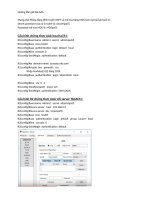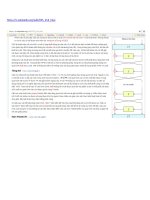Tài liệu môn Thiết Kế Mạng - Võ Tấn Dũng (votandung) Chapter03
Bạn đang xem bản rút gọn của tài liệu. Xem và tải ngay bản đầy đủ của tài liệu tại đây (180.74 KB, 22 trang )
Top-Down Network Design
Chapter Three
Characterizing the Existing Internetwork
Copyright 2010 Cisco Press & Priscilla Oppenheimer
What’s the Starting Point?
• According to Abraham Lincoln:
– “If we could first know where we are and
whither we are tending, we could better judge
what to do and how to do it.”
Where Are We?
• Characterize the existing internetwork in terms
of:
– Its infrastructure
• Logical structure (modularity, hierarchy, topology)
• Physical structure
–
–
–
–
Addressing and naming
Wiring and media
Architectural and environmental constraints
Health
Get a Network Map
Medford
Fast Ethernet
50 users
Roseburg
Fast Ethernet
30 users
Frame Relay
CIR = 56 Kbps
DLCI = 5
Frame Relay
CIR = 56 Kbps
DLCI = 4
Grants Pass
HQ
Gigabit
Ethernet
Gigabit
Ethernet
Grants Pass
HQ
Fast Ethernet
75 users
FEP
(Front End
Processor)
IBM
Mainframe
T1
Web/FTP server
Eugene
Ethernet
20 users
T1
Internet
Characterize Addressing and
Naming
• IP addressing for major devices, client
networks, server networks, and so on
• Any addressing oddities, such as
discontiguous subnets?
• Any strategies for addressing and naming?
– For example, sites may be named using airport
codes
• San Francisco = SFO, Oakland = OAK
Discontiguous Subnets
Area 0
Network
192.168.49.0
Router A
Area 1
Subnets 10.108.16.0 10.108.31.0
Router B
Area 2
Subnets 10.108.32.0 10.108.47.0
Characterize the Wiring and Media
•
•
•
•
•
•
•
•
•
Single-mode fiber
Multi-mode fiber
Shielded twisted pair (STP) copper
Unshielded-twisted-pair (UTP) copper
Coaxial cable
Microwave
Laser
Radio
Infra-red
Campus Network Wiring
Horizontal
Wiring
Work-Area
Wiring
Wallplate
Telecommunications
Wiring Closet
Vertical
Wiring
(Building
Backbone)
Main Cross-Connect Room
(or Main Distribution Frame)
Building A - Headquarters
Intermediate Cross-Connect Room
(or Intermediate Distribution Frame)
Campus
Backbone
Building B
Architectural Constraints
• Make sure the following are sufficient
–
–
–
–
–
–
Air conditioning
Heating
Ventilation
Power
Protection from electromagnetic interference
Doors that can lock
Architectural Constraints
• Make sure there’s space for:
–
–
–
–
Cabling conduits
Patch panels
Equipment racks
Work areas for technicians installing and
troubleshooting equipment
Issues for Wireless Installations
•
•
•
•
Reflection
Absorption
Refraction
Diffraction
Check the Health of the Existing
Internetwork
•
•
•
•
•
•
•
Performance
Availability
Bandwidth utilization
Accuracy
Efficiency
Response time
Status of major routers, switches, and firewalls
Characterize Availability
MTBF
Enterprise
Segment 1
Segment 2
Segment n
MTTR
Date and Duration
of Last Major
Downtime
Cause of Last
Major
Downtime
Fix for Last
Major
Downtime
Network Utilization in Minute
Intervals
Network Utilization
16:40:00
16:43:00
16:46:00
16:49:00
16:52:00
16:55:00
Time
16:58:00
Series1
17:01:00
17:04:00
17:07:00
17:10:00
0
1
2
3
4
Utilization
5
6
7
Network Utilization in Hour
Intervals
Network Utilization
13:00:00
14:00:00
15:00:00
Time
Series1
16:00:00
17:00:00
0
0.5
1
1.5
2
Utilization
2.5
3
3.5
4
4.5
Bandwidth Utilization by
Protocol
Relative
Network
Utilization
Protocol 1
Protocol 2
Protocol 3
Protocol n
Absolute
Network
Utilization
Broadcast
Rate
Multicast
Rate
Characterize Packet Sizes
Characterize Response Time
Node A
Node A
Node B
Node C
Node D
Node B
Node C
Node D
X
X
X
X
Check the Status of Major
Routers, Switches, and Firewalls
•
•
•
•
•
•
•
show buffers
show environment
show interfaces
show memory
show processes
show running-config
show version
Tools
•
•
•
•
•
•
Protocol analyzers
Multi Router Traffic Grapher (MRTG)
Remote monitoring (RMON) probes
Cisco Discovery Protocol (CDP)
Cisco IOS NetFlow technology
CiscoWorks
Summary
• Characterize the existing internetwork before
designing enhancements
• Helps you verify that a customer’s design goals
are realistic
• Helps you locate where new equipment will go
• Helps you cover yourself if the new network has
problems due to unresolved problems in the old
network
Review Questions
• What factors will help you decide if the existing
internetwork is in good enough shape to support new
enhancements?
• When considering protocol behavior, what is the difference
between relative network utilization and absolute network
utilization?
• Why should you characterize the logical structure of an
internetwork and not just the physical structure?
• What architectural and environmental factors should you
consider for a new wireless installation?









